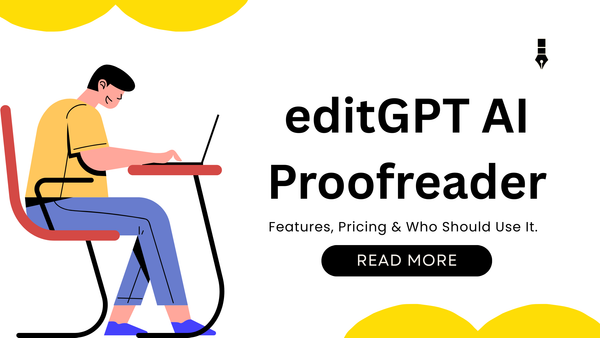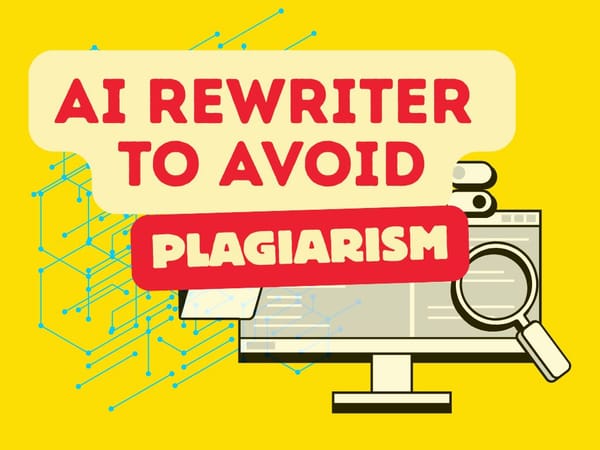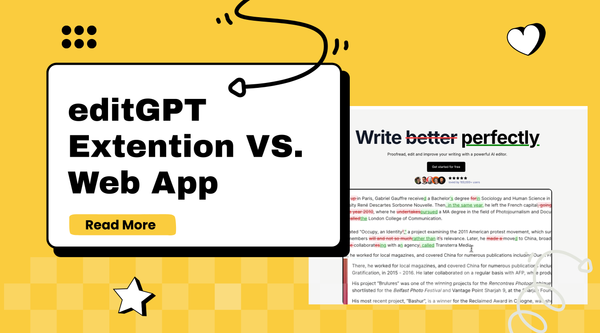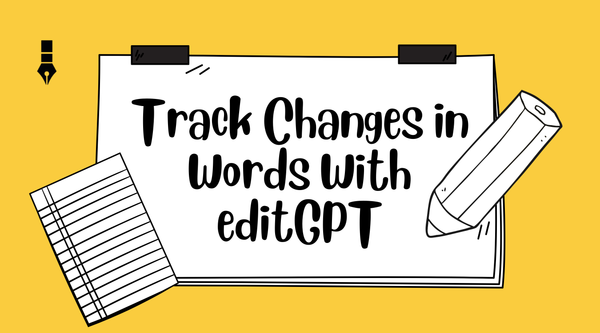editGPT vs Trinka AI: Which is the best Grammarly alternative?
Grammarly isn't enough. Thankfully, there are now a few Grammarly alternatives that can do more than Grammarly does. Read on as we compare editGPT and Trinka AI.

You know it.
Grammarly sure is great at catching typos and basic grammar slips. But what if you’re working on something more, something longer, too, such as a college essay, research paper, or even a full manuscript?
This is where a good Grammarly alternative comes in.
Grammarly has long been the default editing tool for many writers and students. But while it’s quick and easy, it can also get frustrating, especially when it misses context or fails to preserve your intended tone.
That pushed us (like many writers) to explore other options that can actually go beyond surface-level editing.
editGPT and Trinka AI are two of the most talked about Grammarly alternatives today, so we got down to work right away to test drive these two side by side.
Here’s what we learned.
Interface and Ease of Use
editGPT
editGPT has what they call a “writer-first workspace” where the interface and panels are clean and simple so as not to distract the writer. It has just what you need to write or edit efficiently without bouncing between tabs.
We love how its simple efficiency is able to fit perfectly into any of our workflows. Because it’s not hard to learn and navigate (while still being far from basic), it’s flexible enough to be molded into any system.
It also has a project mode where you can easily organize the chapters you want to proofread and edit into sections so you don’t have to suffer a messy hopping between tabs or pages.
And yes, this project mode can also handle large wordcounts, which is perfect if you are looking to edit a full manuscript.
How about the learning curve?
Sure, editGPT has a wide range of advanced features, but it almost has no learning curve at all, thanks to its very basic interface. You have just what you need at hand. The features and buttons are clear and neatly positioned on the toolbar.
There are no unnecessary elements that can distract you.
It’s easy to use, especially for people who are completely new to AI editor tools.
Trinka AI
Trinka AI’s interface looks just like your usual/traditional AI editor, with its right-hand panel that groups grammar and academic suggestions.
While editGPT remains the simpler and easier one when it comes to design, Trinka can still hold a candle, especially with its bit of learning curve.
It needs much effort to learn, while being good for mostly quick passes and shorter documents.
Editing Intelligence
editGPT

If there’s one thing editGPT is best known for, it’s for not being just about correcting grammar.
It’s designed to really understand what you want to say. In short, your intention.
That’s contextual editing for you.
In other words, editGPT doesn’t just mindlessly edit your writing like a bot; It edits just like how an efficient, thinking human editor would.
It will understand the context, your intentions, your purpose, and other nuances, so you don’t lose the original voice of your writing as it’s being proofread and edited.
And in case you’re wondering…
…yes, editGPT can handle large wordcounts without sacrificing the quality of your content.
One of the features we loved is its Project Mode, which let us work on full manuscripts or lengthy documents without losing a consistent tone from start to finish.
You can decide how heavy or light the edits should be, whether you only need a bit of polishing or a deeper restructuring.
And you have a choice to have it extracted complete with tracked changes or continue editing in the web editor.

Another big plus is how well it adapts to your own style and voice, something a lot of editing tools struggle with.
And because you can run as many editing passes as you want…
…it’s easy to keep refining your work until you’re happy with it. All of this makes editGPT especially helpful for longer projects like books, detailed reports, or big client deliverables.

As for the basic features such as grammar and spelling fixes, editGPT can clean your content without touching its original tone and voice, which is very important to us.
And because it’s made to be as intelligent as a human editor, it can also easily smoothen the rhythm of your sentences, trim clutter, and improve transitions, while still giving your the option to accept or reject its smart suggestions.
And did I mention that you can use it in over 80 languages?
You can enjoy editGPT’s smart contextual editing even in your mother tongue. And if you’re looking for a Grammarly alternative with a focus on your particular field, you might find editGPT’s Academic Mode useful.
Its Academic Mode is tailored for specialized fields such as law, medicine, business, and more, ensuring your papers are edited with the proper context and terminology for each discipline.
Trinka AI
One thing we figured out while we were using Trinka AI is that its focus is mostly on accuracy driven by rules.
This means that Trinka AI edits and proofreads your work while strictly adhering to a writing guideline. That makes this Grammarly alternative great for formal and academic writing where rules are everything.
Aside from catching grammar and spelling slips, it also has an auto file edit feature, which allows you to upload a whole document for bulk editing.
But unlike editGPT…
…its bulk editing mode tends to apply suggestions at scale. That causes it to miss the finer details at times, especially if different sections require different settings, tone, and focus.
Accuracy and Reliability
editGPT
In day‑to‑day use, editGPT’s suggestions tend to feel more context‑aware than purely rule‑based.
What does this mean?
It means that this Grammarly alternative tool reads around a sentence before suggesting a change, which cuts down on “technically correct but unhelpful” fixes.
On longer drafts, its Project/long‑form workflow helps keep terminology and tone consistent and quality always high, so the guidance on page 12 still aligns with page 212.
You can also control how aggressive the edits are by selecting different rewrite strengths (light, standard, deep) and tone presets.
Because of this, you’re less likely to get irrelevant or overly strict changes. This is because the tool knows exactly how much to intervene and touch.
And when the meaning of a line is unclear, editGPT doesn’t force a single rewrite. Instead, it offers a couple of clear options, which makes it easier to keep the version that fits your voice best.
See how great contextual editing is?
Trinka AI
Like Grammarly, Trinka AI is great at catching basic grammar and spelling errors, especially in short, formal documents. Think essays, research summaries, and statements of purpose.
Its rule-driven system flags wrong tenses, article use, punctuation, and academic writing with precision and tightens formality where needed.
How about longer documents?
Now, this is where its accuracy can feel a bit less consistent. Two things tend to happen:
- Trinka AI’s uniform rule gets applied by bulk/scale and auto edits, so sections that have idioms, narrative rhythm, or deliberate shifts of tones can receive over-corrections.
- As the terminology, abbreviations, and tone shift from one chapter to the next, this Grammarly alternative may start flagging things you’d already approved or even offer fixes that contradict earlier suggestions.
The way around this is to run Trinka on smaller sections, lock in your preferred terms and abbreviations, and save bulk passes for truly uniform content (methods, appendices, references).
Best Grammarly Alternative Comparison Chart
FAQs
What is a good Grammarly alternative for long content?
editGPT is a great choice if you’re working on long manuscripts, research papers, theses, and the like. Its Project or Long-form workflow keeps tone and terminology consistent across sections, so you’re not redoing the same fixes over and over. Its quality will also stay the same from page 1 to 1,000.
Are Grammarly alternatives worth paying for?
If you write often, yes. Tools like editGPT give you unlimited edits, which can save a lot of time (and money) if you’re working on large drafts. Others, like Trinka AI, are better for people who only need occasional checks on short, formal documents.
Are Grammarly alternatives accurate when it comes to grammar and spelling?
They are, but each tool has its strengths. Trinka AI is very precise with grammar rules and formal writing, but can feel strict if you’re going for a more natural style. editGPT is good at reading the bigger picture, so it’s less likely to make “robotic” corrections that disrupt your flow.
So what’s the best Grammarly alternative?
If you’re looking for a tool that can really step into Grammarly’s shoes, and even go a little further, editGPT stands out among all Grammarly alternative tools for a few key reasons.
Unlike tools that focus only on surface‑level corrections, editGPT works with the context of your entire draft, so its suggestions feel more natural and consistent.
Its range of editing modes and tone controls also means you can fine‑tune exactly how deep you want the edits to go, whether you’re cleaning up a few sentences or reworking a full chapter.
It’s like editing with your own brain, but with less effort!
We also appreciate its Project Mode, which keeps terminology and style aligned across sections without having you edit one file at a time.
Some Grammarly alternatives also have a long-form mode. But only editGPT showed us perfect consistency in quality throughout long chapters. And because you can rerun edits as often as you like, you stay in control of the final voice and flow of your work.
While other tools do well in more specialized settings, editGPT offers the flexibility and depth most writers need in a single platform. It’s the kind of reliability that makes editing feel less like a chore and more like an extension of your writing process.
Recommended Reading
- Video review: This AI Text Editing Tool Is FLAWLESS!
- Best AI Proofreader Tools of 2025 (Tested for Accuracy, Speed & Tone)
- editGPT vs Grammarly vs Quillbot: Which Writing Tool is Best?
- The Best AI Proofreaders That Actually Work (Free & Paid)
- Try editGPT
- Review: Wordtune Editor vs editGPT
- Review: Grammarly vs editGPT
- Review: ProWritingAid vs editGPT
- Review: Hemingway Editor vs editGPT
- Review: editGPT vs Trinka AI: Which is the best Grammarly alternative?
- Best AI Tools for College Essay Editing in 2025
- What is the best AI Proofreader?
- Best AI Proofreader Tools of 2025 (Tested for Accuracy, Speed & Tone)



